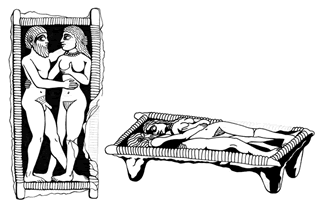 |
|||||||||||||
|
Sacred to Profane Marriage Review "Sacred to Profane Marriage". "Possibly, then, the "Sacred Marriage" rite was not originally concerned with king-making at all, but rather with "goddess-making"; perhaps it was a ritual for, as it were, "activating," making fertile a "Goddess on Earth." To that end, the ceremony entailed ritual mating between the entu-designate and, say, a temple priest, since, for the Mesopotamians, fertility on earth, as in heaven, resulted from the union of male and female.
At some point, one priest might have seen the advantage of continuing to incarnate the goddess's lover, of using the role's charisma to achieve power in the community." ~ "Inanna and the "Sacred Marriage", by Johanna Stuckey. Read the article... |
| Copyright © Redefining the Sacred. All rights reserved. | |
